Photo by Mona Mirpour
There is an unflinching horror within the manga section of your local bookstore. Manga, like any good graphic novel or comic, has the power to reveal a mirror to the reader’s heart — a mirror that, sometimes, brings with it the need to change. So how is horror manga any different than, say, a horror film or horror novel? Besides the pretentious answer of the deep philosophical implications and specific existential ennui of social paranoia, humanity’s collapse and parasitic relationships (to name a few), horror manga’s unique nature comes from its place in Japanese culture and its use of intricate detail.
Much of modern Japanese culture is not too far removed from the technocentric isolationist culture of our own current landscapes. In this space where we are more connected than ever to our closest friends and partnerships, why do we often feel so alone? Recent horror manga such as “Oyasumi Punpun” seek to not answer this question but to bring that introspective look, the mirror, to our lives. Not to mention that the series is crafted by a huge talent, Inio Asano, whose photo-realistic pages seem to transport you directly to the same streets as the isolated protagonist. Asano’s choice of representing the protagonist, Punpun, as a small ever-changing bird creature represents just how removed he is from the rest of life. If any of this intrigues you, the “Punpun” series is best found in print, but the price tag for any manga can be lofty for some. I highly recommend reading online first, then purchasing the series once finished for safekeeping. Trust me when I say that all of these stories do well with several readings and are best experienced in print.
However, maybe you aren’t into stories of bird people struggling with modern life. Maybe you like looking into the void and the void staring back. If existential nightmares and tales of a town plagued by spirals are more up your alley, then I recommend the “king of horror manga,” Junji Ito. Perhaps a good start is with his short manga “The Enigma of Amigara Fault,” where a cliffside is discovered to have human-shaped holes in its side after a recent earthquake has exposed its surface. People from all over come to investigate and are inexplicably drawn to the holes, finding their exact body shape on the cliffside. I won’t spoil the rest, but if you are one for asking “What if?” it is best to give this one a chance. Ito has been world-renowned for years and is a master craftsman in the genre. His largest works, “Tomie” and “Uzumaki” are both representations of how strange and obscure the world around us truly is.
If you are one for the horror of man and the ever adaptable nature of the human spirit, then look no further than the author who inspired Ito, Kazuo Umezu. His magnum opus “The Drifting Classroom” is what happens when “Lord of the Flies” meets post-apocalyptic Japanese children. With its depiction of elementary schoolers fighting off adults and sand monsters alike, the series is impactful in giving readers the distinct sense of hope and determination that children have. A good series to read during finals, when everything seems bleak (trust me on that part).
Okay, time for the blitz round: If you like the first part, look up the title next to it!
Trepanation and psychoanalytic theory: “Homunculus”
End of the world and a creepy one-man cult: “Dragonhead”
Zombies and the fear of dying alone: “I Am A Hero”
Anti-fascism with Frankenstein’s monster to boot: “Lychee Light Club”
How one artist coped with the horrors of war: “Panorama of Hell”
“I don’t like stories, I like creepy pictures!”: Any art piece by Shintaro Kago
“Oh please, I’m not a baby. Give me the really bad stuff.”: “Jisatsu Circle”
Hopefully, I’ve convinced you to punch in the names of some titles or authors into Google. If you have punched them in and are confused, that’s more than alright. These stories aren’t for everyone, and they contain very graphic imagery at times. But what is beautiful about horror manga especially is the way that the medium of manga and comics inherently makes every panel important. When you read, remember that someone was slumped over a desk for a week or two at a time working on this specific section. Much like how we as college students nearly lose ourselves in our work, so have all of these artists. These stories are rarely for shock value, and almost always have a thing or two to say about the human condition. From my own readings since age eight, what I’ve learned the most from this weird and often deeply disturbing genre is that we need each other. As my graduation date draws closer and the fear of “real adult life” sinks deeper in my soul, I feel that now more than ever.
Note: some of these stories contain really graphic material







